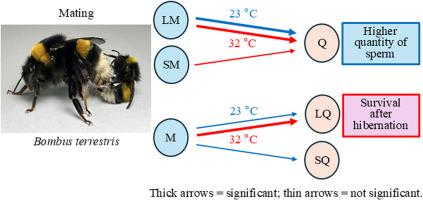气候变暖条件下大黄蜂的体重和配偶选择
IF 2.9
2区 生物学
Q2 BIOLOGY
引用次数: 0
摘要
气候变暖影响了大黄蜂的种群规模、体型和多样性,大黄蜂是农业和生态系统中重要的传粉者。气候变暖导致的发育温度升高导致大黄蜂体型缩小,尤其是工蜂,导致授粉活动减少。然而,温暖环境导致的体重减少如何影响新蚁后和雄蚁后之间的配偶选择尚不清楚。这种相互作用在后代的生存能力中起着重要作用,我们研究了在最佳交配温度和较高交配温度(分别为23°C和32°C)下的雄性-雄性竞争和蜂后配偶选择。在这两种温度下,体型较大的雄性的交配率都明显高于体型较小的雄性。小雄性的交配时间略长,而大雄性的精子数量较多,因此将更多的精子转移到女王的精子囊中。在不同体重的蚁后的交配实验中,在23°C时,大蚁后和小蚁后的交配率没有显著差异,但在32°C时,大蚁后的交配率明显高于小蚁后,说明雄性对大蚁后有强烈的偏好。此外,交配后冬眠后的存活率与其冬眠前的体重呈正相关。这些结果表明,在温暖的条件下,蚁后和雄性的交配偏好发生了变化,这表明在这种环境下,交配选择塑造了后代。本文章由计算机程序翻译,如有差异,请以英文原文为准。

Body mass and mate choice in bumblebees (Bombus terrestris) under climate heating
Climate warming influences the population size, body size, and diversity of bumblebees, important pollinators in agriculture and ecosystems. Increases in developmental temperatures due to climate warming lead to reduction in bumblebee body size, particularly among the worker caste, resulting in reduced pollination activity. However, how reduced body mass resulting from warm conditions influences mate choice between new queens and males remains unclear. This interaction has a major role in viability of subsequent generations, and we investigated male-male competition and queen mate choice in Bombus terrestris at optimal and elevated mating temperatures (23 °C and 32 °C, respectively). At both temperatures, large males had a significantly higher mating rate than small males. Small males exhibited slightly prolonged mating, while large males transferred more sperm to queens’ spermathecae owing to their higher sperm count. In mating experiments with queens of different body weights, no significant difference was observed in the mating rate between large and small queens at 23 °C, but at 32 °C, large queens had a significantly higher mating rate than small queens, indicating strong male preferences for large queens. Additionally, the survival of mated queens after hibernation was positively correlated with their body weight prior to hibernation. These results demonstrate the changes in the mating preferences of queens and males under warm conditions, suggesting that mate choice shapes subsequent generations in such environments.
求助全文
通过发布文献求助,成功后即可免费获取论文全文。
去求助
来源期刊

Journal of thermal biology
生物-动物学
CiteScore
5.30
自引率
7.40%
发文量
196
审稿时长
14.5 weeks
期刊介绍:
The Journal of Thermal Biology publishes articles that advance our knowledge on the ways and mechanisms through which temperature affects man and animals. This includes studies of their responses to these effects and on the ecological consequences. Directly relevant to this theme are:
• The mechanisms of thermal limitation, heat and cold injury, and the resistance of organisms to extremes of temperature
• The mechanisms involved in acclimation, acclimatization and evolutionary adaptation to temperature
• Mechanisms underlying the patterns of hibernation, torpor, dormancy, aestivation and diapause
• Effects of temperature on reproduction and development, growth, ageing and life-span
• Studies on modelling heat transfer between organisms and their environment
• The contributions of temperature to effects of climate change on animal species and man
• Studies of conservation biology and physiology related to temperature
• Behavioural and physiological regulation of body temperature including its pathophysiology and fever
• Medical applications of hypo- and hyperthermia
Article types:
• Original articles
• Review articles
 求助内容:
求助内容: 应助结果提醒方式:
应助结果提醒方式:


